How to shelter grapes for the winter?

Knowing how to cover grapes for the winter, you can confidently avoid problems with preserving its qualities. It is only necessary to figure out how to properly cover the culture, when to do it and how to close young grapes from the cold. Once you understand these topics, with simple and reliable ways to create quick and easy cover, you can study additional tips for a deeper understanding of the topic.
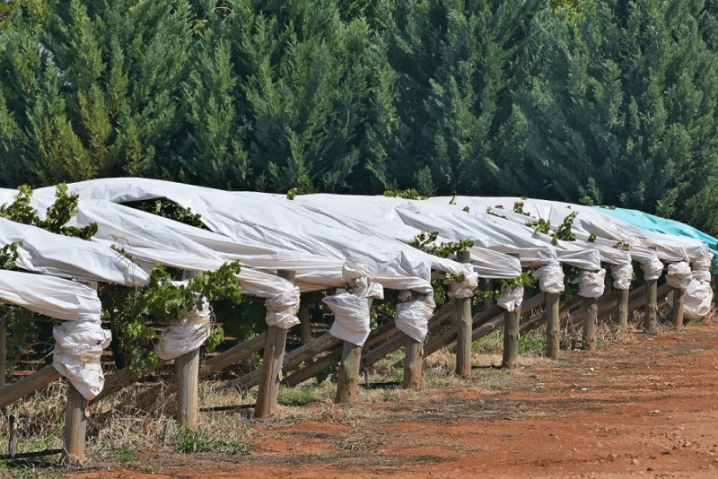
When should you cover?
Determining the exact moment when it is time to make a shelter is very important. If you miss this deadline, you will have to say goodbye to hopes for a good harvest next season. It is necessary, first of all, to focus on the climatic characteristics of certain regions and localities. You should not rush to isolate the vine from the external environment - if it has not yet completed the natural vegetative cycle of the warm period, instead of benefit, there will only be harm. In very warm autumn, prematurely harvested shoots can rot and rot.
Professional growers begin covering work at the first autumn frosts.
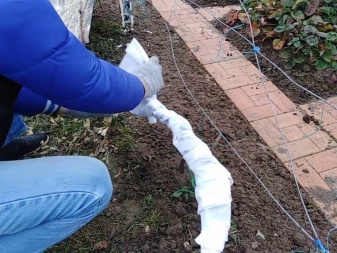
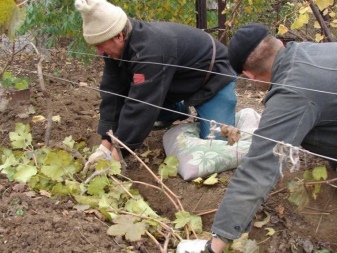
Geographic table
The sensitivity of the vine to the cold is quite large, therefore, it needs shelter throughout the territory of our country, not excluding the Black Sea coast. But still there is a gradation of the approximate terms of covering works. Despite the fact that in a particular season the need for them may arise earlier or later, this is exactly the time when everything should definitely be ready for work. The required averaged information can be seen in the table below.
It is also worth considering the peculiarities of the variety, and the nuances of a particular economy, and many other subtleties.
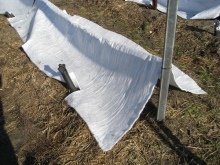
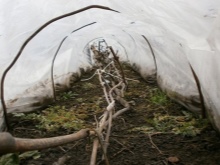
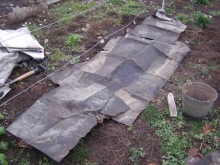
|
Region |
Shelter times and measures |
|
Siberia and the Urals |
Temporary shelter in late September - early October, final in 30-40 days |
|
Moscow suburbs |
Approximately November, 3-layer protection |
|
Middle lane |
Usually in mid-November, with weather adjustments, about 30 days after the end of the leaf fall |
|
Volga region |
With the onset of frost on the soil |
|
Black earth |
Without clear indications of dates, with the onset of frost 1-3 degrees |
|
Krasnodar region |
October-November, about 2 weeks after the end of leaf fall and after treatment with protective compounds |
|
Primorsky Krai |
Mid to late October, sometimes a little later |
|
Kaliningrad and Leningrad regions |
No later than early October |
|
Karelia |
No clear deadlines, immediately at the onset of frost |
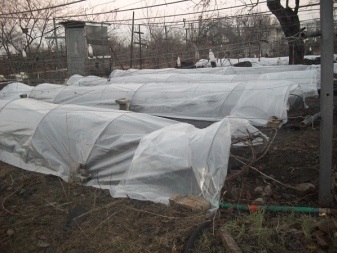
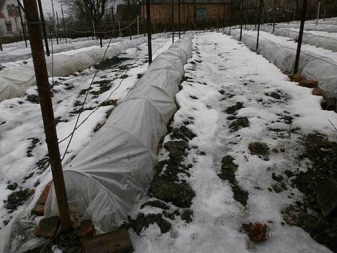
Preparatory work
Moisture charging
This procedure should be done after the first frost. But one must understand that sometimes, due to weather conditions, they do not come, and the preservation of the green foliage does not allow one to guess what to do. In this case, the "guiding star" will be the average daily temperature index. As soon as it is no more than +10 degrees for 10 days, you can immediately start water-charging irrigation. You should not rush and try to “work ahead of the curve”.
If moisture charging is started at a temperature index of 10.1 to 14.9 degrees, then this is simply an unnecessary water consumption. If the temperature is even higher, the growth of the kidneys will begin prematurely, which should normally produce fruits for the next year.Then you will have to part with thoughts of the harvest, and sometimes - with the bush itself in general. But just determining the right time is not enough. Novice gardeners and winegrowers often cannot decide how much water should be poured.

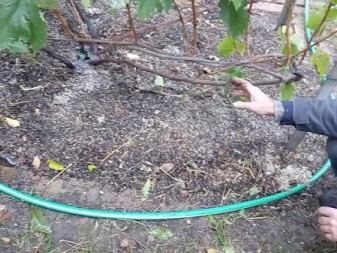
The solution to this problem is very simple: you need to focus on how much you manage to pour under the bush. Ideally, water should be poured until it stops absorbing into the ground and a puddle begins to form. However, such an opportunity, provided by a main water supply system or an individual well, is not available everywhere. Therefore, in some cases, a kind of compromise is the use of 100 liters of water per 1 adult plant. With such a minimum consumption, it is possible to ensure a normal wintering.
Young grape shoots are charged with water at the rate of 30-50 liters per 1 bush. However, whenever possible, these figures should be exceeded. Long-term practice of various farms consistently demonstrates that the more the grapes are "charged" with moisture, the easier it overwinters and the more efficiently it bears fruit in the next season. After heavy rains, if the ground is moistened by 0.6-0.8 m (this must be checked, and not assessed by eye on the surface), special water-charging irrigation is not needed.
If the moisture is less, there is no way to do without it.
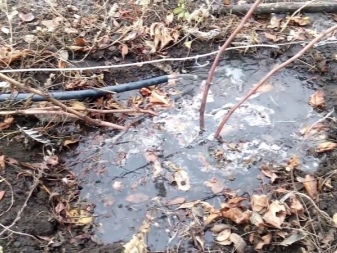
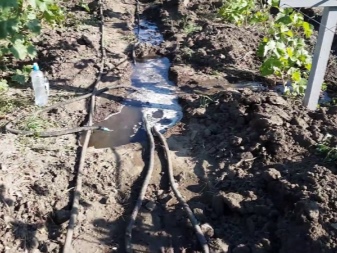
Top dressing
This procedure should be started immediately after harvesting. Falling leaves should be prevented so that each falling leaf brings useful substances into the ground, and is not depleted, as is usually the case by the end of summer. Usually, autumn feeding is reduced to spraying with a solution of magnesia. Only potassium monophosphate is laid in the ground.
Do not increase the dose. Inexperienced gardeners often try to introduce various fertilizers as much as possible. It can give nothing but harm to the plant. Due to the excessive amount of phosphorus, for example, vegetation is inhibited. The optimal quantities of any drugs are indicated on the packaging, they have been worked out by experience and analyzed by dozens of trained specialists.
Grape growers often prefer compost and manure. This is also quite a good practice, and it fits perfectly with the latest trends in organic farming. The dry method of introducing humus assumes that it will simply be buried in the root ring. The method of "embedding in a hole" implies the maximum approximation of the composition to the roots.
Just before winter, you can put some ash under the vine.
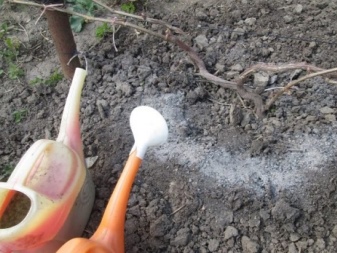
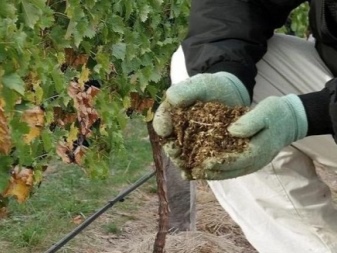
Treatment against diseases
It is conducted in two stages. First, as soon as the crop is harvested, an insecticide is used. You can adhere to the maximum allowed dosage and concentration - all the same, there is no longer any risk, and the fewer harmful insects overwinter, the better. You can choose a drug to your liking. A very good option is "Aktara", which should be used for many other plants. If in the warm months the vineyard was affected by a fungus, insecticides are combined with fungicides, but in case of forced treatment in relatively warm weather, it is necessary to give preference to the Bordeaux mixture and other substances with a gentle effect.

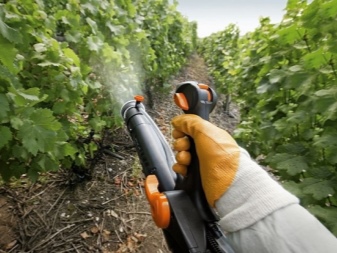
From the available means to combat threats, the grower can use:
- tar soap;
- ash solution;
- table vinegar;
- potassium permanganate;
- ordinary laundry soap;
- hydrogen peroxide (but all of these options except the last are very weak).
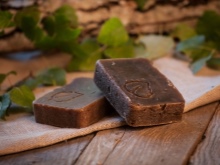
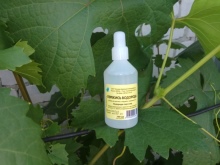
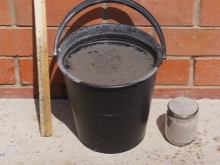
Pruning
You can approach the vine with a pruner in your hands only after the last leaf lies on the ground. Even deformed and partially dried leaves continue to fulfill their function to some extent - and we must let them do the main thing to the end. Pruning in wet weather is strongly discouraged. The only excuse for her will be the situation when there is no other time, when heavy rains have charged, for example.
The exact time of pruning in the fall is determined by taking into account the geographical location of the vineyard:
- in the North Caucasus region - the last third of autumn;
- in the vicinity of Moscow - October;
- September is the optimal period for Siberian, Ural, and Far Eastern gardeners.
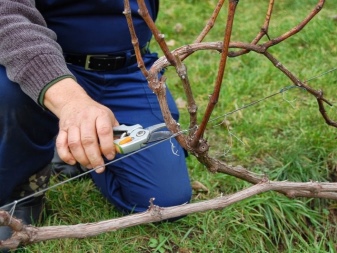

As a pity for the time, it is very important to wipe and disinfect the pruner when moving to each new bush. Vines can become infected very easily. Treatment of the transferred infection will be extremely difficult, sometimes completely impossible. In order not to wipe, you can simply keep a jar of alcohol at the ready while working. It is enough to dip the instrument there to eliminate all infectious factors.
The earliest bushes in the first years of development must be cut very carefully. Only 2 or 3 buds are left. The length of the trunk must correspond to the dimensions of the trellis. External buds with good development of the vine do not need to be cut off. In adult grape bushes, all withered thin branches are cut out, hemp should not remain.
Sometimes you have to work with a seriously neglected grape bush. You need to focus on the thickness of the largest branch with perennial wood. It is necessary to understand that even a well-developed root system is not able to supply 5 or more vines with nutrients. The oldest and youngest branches should be removed.
Forming a vine into an arch does not require shortening, it only needs to be guided.
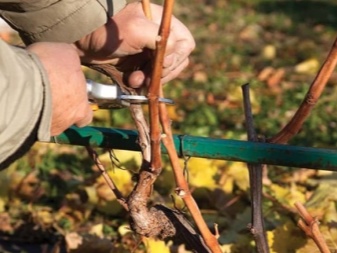
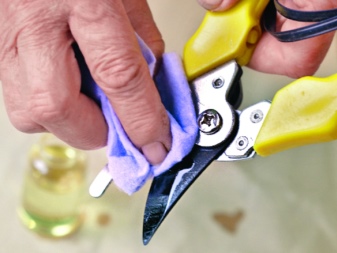
Effective hiding places
Hilling soil
Covering grapes with earth is easier than other options. This method is ideal for first year plants. The size of the embankment should be 200-250 mm. With the formation of a reliable snow cover, this protection is quite sufficient.
When working with more developed bushes, it is necessary to pre-cover with straw, rags, plastic bottles.
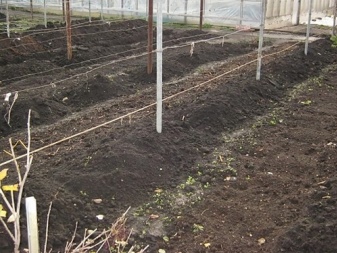
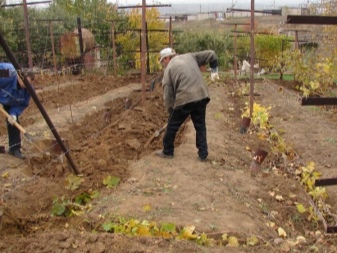
Semi-shelter
This method is quite good if the average winter temperature is not lower than -15 degrees. A semi-shelter is constructed from rags, straw and similar items. The result is simple and reliable. You just need to make a cocoon with a layer of 30-50 mm.
Draping with twine is recommended; the problem is that such solutions will not cope if the frosts are too strong.
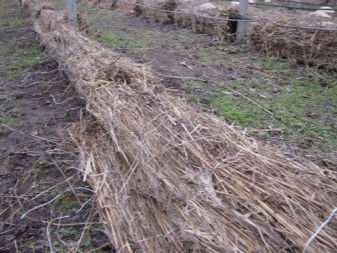
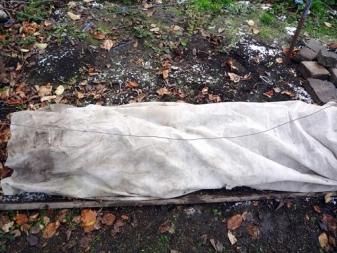
Full cover
This is the most serious solution, requiring maximum consumption of materials and their careful selection. Full cover should be used even in places with relatively mild cold weather, if the snow is relatively thin. The usual approach is to place 1 cm of covering material 1 degree below zero degrees. That is, in Siberia, the Urals and the Far East, the shelter should be at least 50 cm. It should be created only on dry days.
It is imperative to deal with some of the intricacies of using specific covering materials. Foliage is often used to protect grapes in winter. This method works especially well in the northern regions, where earth protection is ineffective.
The recommendations are as follows:
- prepare leaves in advance (poplar leaves are best);
- keep them in piles 40-45 cm high under a polyethylene cover;
- pin the vine after the start of frost directly to the ground, without any grooves;
- with the onset of severe frosts, cover the bush with 30-35 cm of leaves, then with polyethylene, then with tomato tops and other materials that improve snow retention.
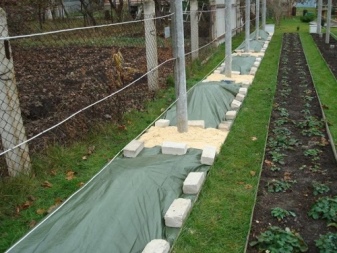

Some people use spruce branches. Such material is readily available in any wooded area. The layer of spruce branches should be 30-40 cm. Harmful rodents do not start in such a shelter. Excellent ventilation is provided, however, it is not possible to find suitable material everywhere.
But in any place it is not difficult to buy spunbond. Agrofibre itself works well in relatively warm places. In colder regions, it can be used in conjunction with mulch and other auxiliary materials. Spunbond shelter is compatible with placing grapes directly on trellises.
But in any case, it must be fastened very securely, otherwise even the weakest wind will be an unpleasant surprise.
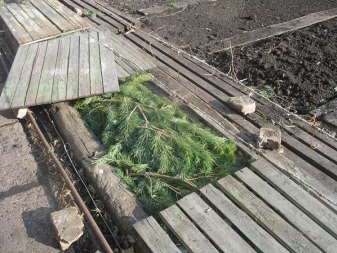
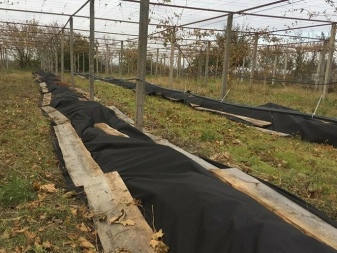
Features of the shelter of young grapes
This work can be done quickly and easily if you take into account the basic recommendations. Plants of the first year, as well as annual crops, are supposed to be protected as soon as the average daily temperature drops below +5 degrees. These are especially delicate plants, and extra precautions will not hurt. Top dressing of young shoots is carried out a maximum of 3 weeks before the arrival of frost. You can even do it earlier - it will still benefit the plants.
But some recommend not feeding young bushes at all as winter approaches. Pruning them is also contraindicated. The best way to isolate is high hilling. In areas with cold climates, foliage or spruce branches should be used.
The vine itself under such protection is not required to be additionally wrapped.
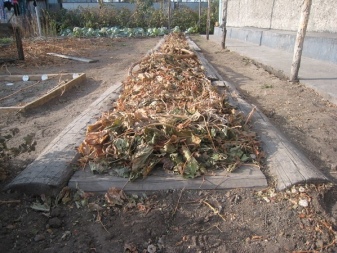
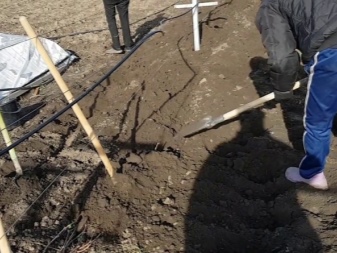
Shelter in areas with very harsh winters
Such conditions force the use of a three-layer thermal protection. They start with sprinkling with soil to a height of 50-150 mm. Next, there is 50-100 mm of organic matter. And in the last turn, the earthen backfill is formed with a layer of 150-250 mm. With a persistent lack of snow in winter, it is advisable to pour wide rollers from the soil. To protect the roots from frost, spread mulch - reeds, peat, straw or dry garden grass; oiled paper does not work at all.
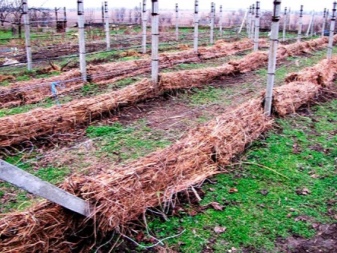
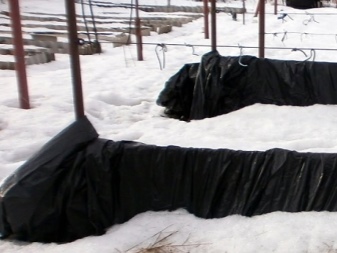
Shelter rules
Do not think that if the grapes are grown in a greenhouse, then this automatically solves the whole problem. Preparations for wintering are about the same as in open areas. First of all, it is necessary to remove all bushes from the trellises. They are treated with iron vitriol. The shelter is formed strictly from natural fabrics - any synthetics are unacceptable inside greenhouses.
With full cover, after the end of the shedding of the foliage, the bush is cut to the required size. After the fabric, put a film. Then the plant is pressed against the soil with special staples. So that it does not straighten, pour the soil. Its layer, depending on the strength of frost, can reach 300 mm.
If severe cold does not occur, then the shelter must be ventilated. Emergency protection in case of unexpectedly severe frosts - pressing the grapes to the soil and soil filling. Excessively strong thermal insulation is impractical, otherwise the plants will rot. For her, the land that was originally close to the bushes is not suitable.
Of course, you need to think carefully about everything, monitor the weather.
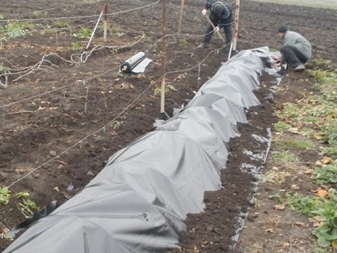
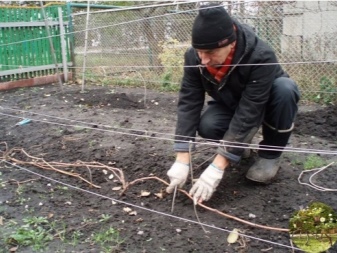
Do all varieties need to be covered?
Technical and individual universal grape varieties can theoretically overwinter if the temperature is at least -20 degrees. They are distinguished by good frost resistance:
- "Isabel";
- Concorde;
- Lydia.
However, it is necessary to take into account the real severity of the weather, and not just temperature indices. In the southern regions of the country, many varieties can indeed hibernate without shelter. But it's better to play it safe and take care of the plants. Sometimes even a purely physiologically preserved culture after freezing will not please the harvest. This outcome is unlikely to please gardeners.

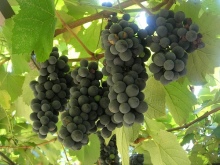
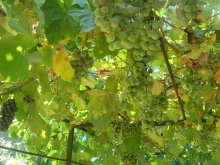
Advice
The bush should not be allowed to touch the ground. For any covering work, the root system must be protected. The bush, hardened and ready for insulation procedures, has a light brown bark. When using a film, it must be fixed:
- boards;
- natural stone;
- brick;
- fittings.
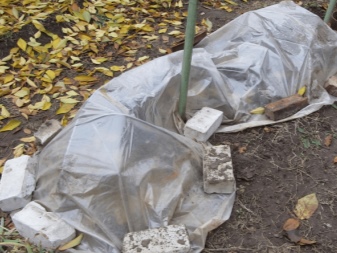

If the vine plantations are oriented to the north, fall under the dominant direction of the winds, or if the site is highly humid, the thermal protection should be more powerful than in the usual option. Dense wrapping of the vine with films, other waterproof materials is unacceptable. A ventilation hole or even two such channels must be made in them. When insulating vines in an open area (not in a greenhouse), the layer of snow on top of the layout should be at least 50 cm.
If the vine has not ripened, has not turned brown by the required time, it is dug up and transplanted into a pot. The pot itself is kept in moderate heat all winter (from 10 to 15 degrees). In some cases, slate is used for shelter. The use of lime helps to reduce the likelihood of debate. It is not possible to remove the thermal insulation earlier than April - but this is also permissible only when there is no danger of an early frost.
The grapes growing on the gazebo is a separate important topic. Shelter even for a young, large vine is very difficult. A few years after landing, this is almost completely unattainable. We'll have to choose the most frost-resistant varieties.
But even this does not allow growing crops on gazebos anywhere except in the southernmost regions.

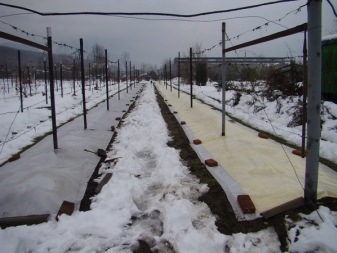
You can find out how to cover a young grape bush for the winter in the year of planting from the video below.







The comment was sent successfully.